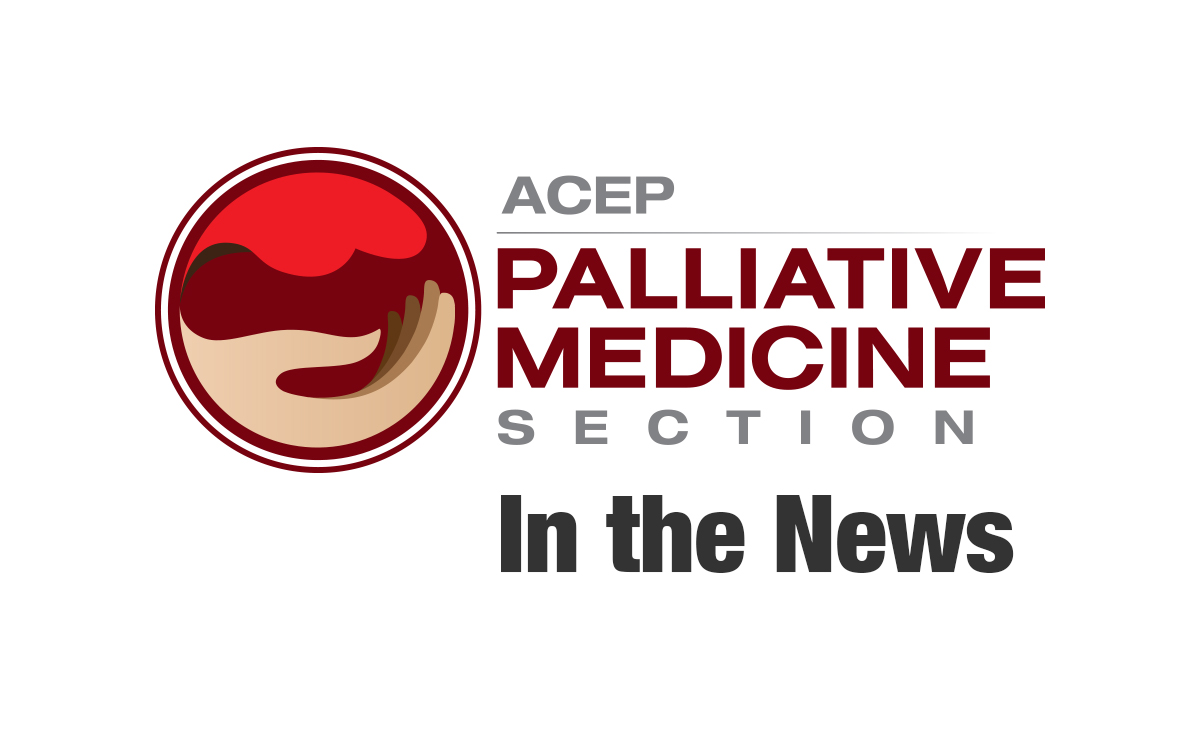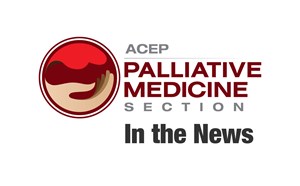
Palliative Pulse - April 2025
Table of Contents
- Chair’s Corner
- Clinical Pearl
- Education/Training Resources
- Research Articles of the Month
- Announcements
- Upcoming Events
- References
Chair’s Corner
Dear Palliative Care Section Members,
I was pleased to see excellent engagement at our last meeting in March. I continue to appreciate the broad range of clinical experience and practice settings of our group. Our shared expertise helps us to collaborate in opportunities to further our field and to mentor our members who are earlier in their career and/or training who are exploring what it looks like to work in palliative care in addition to emergency medicine. In addition, many of us are championing opportunities to better integrate palliative care interventions into the ED in our respective practice environments. We have an extremely passionate and productive group of members. Our collaborations in ongoing key initiatives also help to combine efforts with others in our field and the work of other interest groups in EM/palliative care. It is truly inspiring to get to work with all of you.
This work requires a lot of us clinically, professionally, and emotionally, so sharing our common motivating factors can add to our resilience and provide an additional layer of collegial support. I had the opportunity today to speak to our graduating class of medical students in their preparation for residency course they complete at the end of their program. My task was to give them a crash course on dealing with many aspects of end-of-life care that they will soon experience as interns. While they will all be entering a variety of fields, it was apparent that they engaged with points on communication in critical illness, dealing with families, addressing symptoms, and compassionately sharing bad news, among many other themes. We are at the tip of the spear in the ED with so many aspects of the medical system. This places us in an optimal position to impart knowledge to our colleagues inside and outside of EM. I always enjoy talking to medical students because I perceive them to be at a more malleable stage of their training, but I hope that I never lose sight that our efforts can still teach those of us well beyond our initial medical training.
Continue the excellent work that all of you do,
Justin Brooten, MD, FACEP
ACEP Palliative Medicine Section Chair
Clinical Pearl
You’re in a busy ED when EMS rolls in with an 82-year-old woman with advanced heart failure, altered mental status, and hypotension. Her daughter looks at you anxiously: “She wouldn’t want to suffer, but I don’t know what to do.” With limited time, you need to guide her through a code status decision while ensuring clarity and compassion.
Stepwise Approach to the Conversation
- Ask what they know
- “I am sorry to meet you this way. What have you heard about what has happened today to your loved ones?”
- Break bad news
- Warning shot: “I am afraid I have serious news. Would it be okay if I share?”
- Headline: “Your [ ] is not breathing well from [ ]. With her other health issues, I am worried she could become/is very sick and may even die.”
- Establish urgency. Align:
- “We need to work together quickly to make the best decision for her care.”
- Baseline function:
- “To decide which treatments might help your [ ] the most, I need to know more about her. What type of activities was she doing day-to-day before this illness?”
- Patient’s values:
- “Has she previously expressed wishes about the kind of medical care she would or would not want?”
- “If time is short, what is most important to her?”
- “How much would she be willing to go through for the possibility of more time?”
- “What abilities are crucial to her that she would consider life not worth living if she lost them?”
- “Are there states she would consider worse than dying?”
- Summarize:
- “What I hear is___. Is that correct?”
- Make recommendations
- “Based on what I’m hearing from you, this means we will focus on ___. We will do ___ and not do ___.”
- Forecast (if admitted):
- “I hope these treatments will help your [ ]. We are still very worried about how sick she is. The inpatient team will discuss with you how she is doing and if she is responding to treatment in the next 24 to 48 hours.”
Why This Matters
Emergency medicine physicians frequently navigate these challenging discussions in time-sensitive situations. Practicing a structured approach helps ensure that patients receive care aligned with their values concise and effective way.
Education/Training Resources
Emergency Medicine and Palliative Careers Resource
Developed by SAEM/RAMS and provides concise and high yield roadmap for trainees or colleagues interested in growing in this field. It provides valuable information for different stages of training and career, from medical student to mid-career transition as well as consolidation of resources.
VitalTalk Quick Guides for Emergency Medicine: Essential Communication Tools
VitalTalk provides a series of quick guides designed to enhance communication skills for healthcare professionals, especially in high-pressure environments like the emergency department. These concise, one-page resources can help emergency medicine physicians navigate critical conversations with patients and families facing serious illness.
Key Guides:
- Bridging Inequity
Techniques for addressing and understanding diverse patient experiences, particularly in the fast-paced ED environment. This guide helps you approach each patient with cultural humility. - First Visit
Best practices for establishing trust and setting the agenda during initial, often rushed, encounters with patients facing serious illness or injury. - Serious News
The GUIDE framework helps EM clinicians deliver difficult news with compassion and clarity, ensuring patients and families understand their situation without overwhelming them. - Discussing Prognosis
The ADAPT tool offers a structured approach to prognosis discussions, focusing on clarity, empathy, and making complex information understandable. - Transitions/Goals of Care
Use the REMAP tool to help align goals of care during critical moments, ensuring that even in the fast-paced ED, you can facilitate meaningful conversations about what matters most to patients. - Responding to Emotion
Learn how to use NURSE statements to validate patient emotions, especially in situations of distress or uncertainty, which are common in the ED setting. - Family Conferences
Guidance for involving family members in decision-making, especially in cases involving serious or life-threatening conditions. - Conflicts
De-escalation techniques to manage conflicts that may arise in the ED, ensuring you can move forward with productive, patient-centered conversations. - Talking About Dying
Approaches for addressing end-of-life care decisions, particularly when patients are facing imminent death or are too sick to recover. - PAUSE Talking Map
Approach to having “early” goals of care conversations for those who are not imminently dying
Research Articles of the Month
Palliative Care Initiated in the Emergency Department: A Cluster Randomized Clinical Trial
Grudzen, J., et al. (2025). Emergency Department-Initiated Palliative Care and Hospital Admissions: A Randomized Clinical Trial. JAMA, 2025; 333(4): 345-356.
What the Author Did:
The study is a multisite, across 29 EDs, randomized clinical trial that investigates whether integrating early palliative care in the emergency department (ED) can reduce hospital admissions for patients with serious illness. Emergency physicians, physician assistants, nurse practitioners and nurses received 3-weeks intervention with training and education on primary palliative care. The trial assessed the impact of ED-initiated palliative care intervention on patient outcomes such as hospital admission, subsequent health care use, short-term mortality in older adults with serious, life-limiting illness. Results showed that the intervention to initiate palliative care in the ED did not have an effect on hospital admission, subsequent health care use, or short-term mortality in older adults with serious, life-limiting illness.
Why It Matters:
Research is underdeveloped in primary palliative care provided by clinicians who are not palliative specialists. This study demonstrates that primary, as opposed to specialty, palliative care interventions were less comprehensive and effective. Specialty palliative care interventions have also demonstrated stronger evidence for addressing palliative care needs, such as physical symptoms. Despite these challenges, development and implementation of primary palliative care interventions remain priority, given the workforce shortage in palliative medicine.
Announcements
Meeting Schedule: Our meeting has fallen monthly just before the SAEM Palliative interest group meeting, and as there are many of us who are part of both groups, it can be problematic to have a two-hour block of afternoon meetings every other first Thursday of the month. Satheesh Gunaga, DO, FACEP, FACOEP, who is the chair of the SAEM palliative interest group has kindly agreed to alternate months with our group. Since SAEM falls in May, they will omit their meeting that month and will resume meeting June 5th, so that their group will continue meeting in even months and we will continue meeting in odd months. If you have any old meeting invites on your calendar which fall outside of this, you can delete those.
Justin Brooten, MD, FACEP is pleased to announce that he began a new role as Interim Program Director for the Hospice and Palliative Care Fellowship at the Wake Forest School of Medicine, in Winston Salem North Carolina on April 1st. He hopes to use this role to continue to promote training of emergency physicians in palliative care and advancing integration of palliative care and emergency medicine integration.
Upcoming Events
SAEM 2025 Annual Meeting, May 13-16, 2025
Palliative Medicine Interest Group Sponsored Events:
The Right Fit: Designing a Palliative Care Curriculum to Meet the Needs of Your Residency (RAMS- and Palliative Medicine Interest Group-Sponsored)
5/14/2025 2:30-2:50pm@ Location: Grand Ballroom Salon B: Level Five
Guestimates, Estimates, and Survival Curves: Harnessing Science to Inform Emergency Department Prognosis for Seriously Ill Patients (Palliative Medicine Interest Group- and Critical Care Interest Group-Sponsored)
5/15/2025 11:00-11:50am@ Independence Ballroom III: Level Three
Pioneering Palliative Protocols: Integrating End-of-Life Care Into Emergency Medical Services Practices (Emergency Medical Services Interest Group and Palliative Medicine Interest Group Sponsored)
5/16/2025 10:00-10:20am@ Franklin 3: Level Four
Honoring the Moment: Exploring the How and Why of Defusing Emotions After a Patient's Death (Wellness Committee, and Palliative Medicine Interest Group Sponsored)
5/16/2025 11:00-11:50am@ Franklin 6: Level Four
SAEM Palliative Medicine Interest Group Meeting
5/16/2025 9:00-9:50am@ 305-306: Level Three
References
- (n.d.). Rapid code status conversation guide. Academic Life in Emergency Medicine. Retrieved April 2, 2025,
- Vital Talk Quick Guides.
- Palliative Care Initiated in the Emergency Department: A Cluster Randomized Clinical Trial . Grudzen, J., et al. (2025). Emergency Department-Initiated Palliative Care and Hospital Admissions: A Randomized Clinical Trial. JAMA, 2025; 333(4): 345-356.
- SAEM/RAMS Roadmap for Palliative Medicine.



